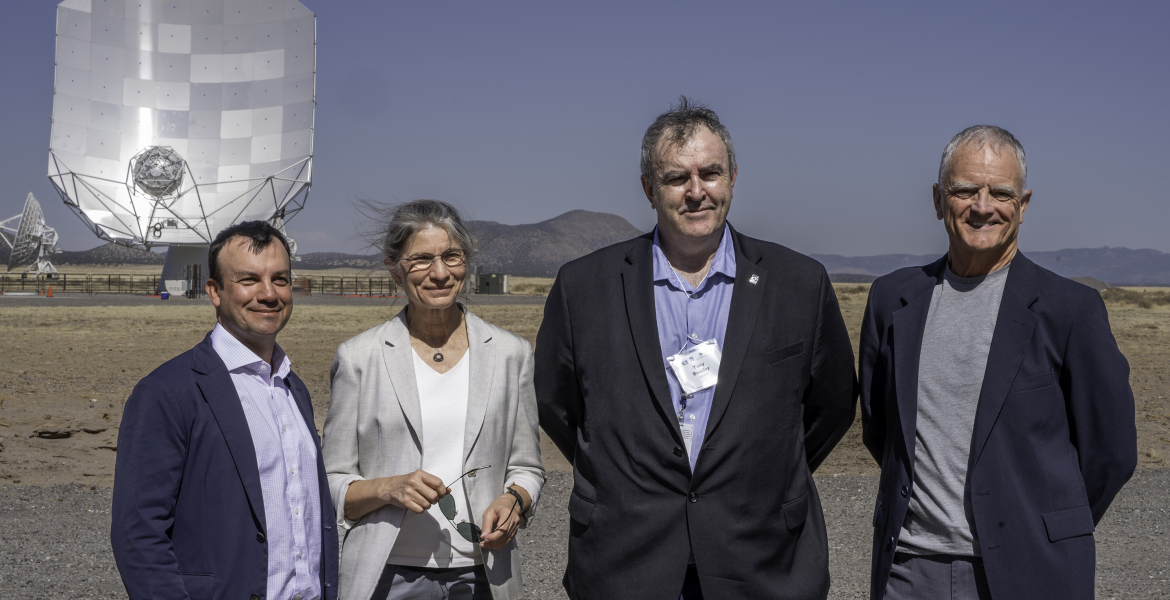Peering back in time, around 12 billion years, astronomers using the Atacama Large Millimeter/submillimeter Array (ALMA) have found the most distant and direct evidence of scorching gas in a forming galaxy cluster, SPT2349-56. The hot plasma, seen when the Universe was just 1.4 billion years old, is far hotter and more pressurized than current theories predicted for such an early system.
Recent News
Cosmic Lens Reveals Hyperactive Cradle of Future Galaxy Cluster
Astronomers using the U.S. National Science Foundation Very Large Array (NSF VLA) and the Atacama Large Millimeter/submillimeter Array (ALMA) have discovered a rare protocluster that was exceptionally bright, all when the Universe was 11 billion years younger. The system, called PJ0846+15 (J0846), is the first strongly lensed protocluster core discovered, revealing how some of the most massive galaxy clusters in the present-day Universe began their lives.
Stars That Die Off the Beaten Path
Astronomers have created a detailed forecast of where they expect to observe future stellar explosions in a nearby galaxy, opening a new window into how exploding stars shape the cosmos.
University of Florida and NSF NRAO Forge Path for Discovery

New partnership brings the future of astronomy and science education, inspiring students and communities
The U.S. National Science Foundation National Radio Astronomy Observatory (NSF NRAO) and the University of Florida (UF) have announced a dynamic new partnership to advance science education and public outreach at a future Next Generation Very Large Array (ngVLA) antenna site in Florida.
This collaboration, signed with a Memorandum of Understanding (MOU) at the debut of the ngVLA prototype antenna in New Mexico last week, brings together world-class scientific expertise and educational leadership to create unique opportunities for students, educators, and the public across Florida. If constructed, the ngVLA, a flagship project recommended by the Astro2020 Decadal Survey, would be the most advanced radio telescope of its kind, capable of probing the universe with unprecedented sensitivity and resolution
The ngVLA Florida LONG station—one of 10 such planned sites nationwide—will not only contribute to groundbreaking discoveries in astronomy and physics but also serve as a hub for hands-on science education, STEM training, and community engagement. The partnership envisions:
- Innovative educational programs for K-12, high school, and university students
- Public outreach events and a potential visitor center to inspire curiosity in science
- Research and training opportunities for UF students, including engineering and astronomy projects
- Site-based science activities and technology demonstrations for all ages
Potential locations for the Florida ngVLA antenna include UF-affiliated sites such as the Southwest Florida Research and Education Center in Immokalee,the Everglades Research and Education Center in Belle Glade and the DeLuca Preserve in Yeehaw Junction, ensuring deep local ties and broad accessibility.
“By uniting the cutting-edge resources of NRAO with the educational mission of UF, this partnership will spark discovery, empower future scientists, and ensure Florida plays a leading role in the next era of astronomical exploration,” said Robert Ferl, distinguished professor and director of the UF Astraeus Space Institute.
The NSF NRAO is actively engaged in conversations with other universities to identify locations for other ngVLA antenna LONG stations. “There is enormous potential for these collaborations to create even more educational opportunities for students and communities across the country,” adds NSF NRAO ngVLA project scientist Eric Murphy, “We’re excited to be formalizing our plans and signing MOUs with other universities soon.”
About NRAO
The National Radio Astronomy Observatory and the Green Bank Observatory are major facilities of the U.S. National Science Foundation, operated under cooperative agreement by Associated Universities, Inc.
This news article was originally published on the NRAO website on April 29, 2025.
Recent News
New Discovery Challenges Evolution of Galaxy Clusters
Peering back in time, around 12 billion years, astronomers using the Atacama Large Millimeter/submillimeter Array (ALMA) have found the most distant and direct evidence of scorching gas in a forming galaxy cluster, SPT2349-56. The hot plasma, seen when the Universe was just 1.4 billion years old, is far hotter and more pressurized than current theories predicted for such an early system.
Cosmic Lens Reveals Hyperactive Cradle of Future Galaxy Cluster
Astronomers using the U.S. National Science Foundation Very Large Array (NSF VLA) and the Atacama Large Millimeter/submillimeter Array (ALMA) have discovered a rare protocluster that was exceptionally bright, all when the Universe was 11 billion years younger. The system, called PJ0846+15 (J0846), is the first strongly lensed protocluster core discovered, revealing how some of the most massive galaxy clusters in the present-day Universe began their lives.
Stars That Die Off the Beaten Path
Astronomers have created a detailed forecast of where they expect to observe future stellar explosions in a nearby galaxy, opening a new window into how exploding stars shape the cosmos.
